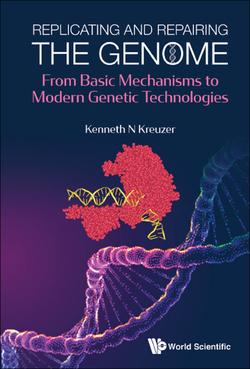Читать книгу Replicating And Repairing The Genome: From Basic Mechanisms To Modern Genetic Technologies - Kenneth N Kreuzer - Страница 24
На сайте Литреса книга снята с продажи.
2.8Finalizing the lagging-strand product
ОглавлениеThe reactions described above can provide a fully intact, duplex DNA molecule as the leading-strand product. However, the lagging-strand product will consist of one intact parental strand along with a product strand that has an interruption and a small segment of RNA where each Okazaki fragment was initiated. These imperfections are repaired following the main replication reaction to generate the fully intact DNA products (Figure 2.8).
Figure 2.8.Okazaki fragment processing. The sequential action of a 5′ to 3′ exonuclease, DNA polymerase, and DNA ligase result in removal of the RNA primer and sealing of adjacent Okazaki fragments into an intact strand.
An additional T7 protein6 is a specialized nuclease with two key activities. First, this protein is a 5′ to 3′ exonuclease and plays an important role in removing the RNA primers at the 5′ ends of each Okazaki fragment. Second, the protein has an activity called “flap endonuclease,” which can cleave off a short segment of extra DNA or RNA at a nick. We will return to a discussion of flap endonucleases when we discuss eukaryotic DNA replication in Chapter 4.
In addition to processing Okazaki fragment ends, the T7 exonuclease also plays a key role in degrading the bacterial host DNA during T7 infection. T7-encoded nucleases degrade the host DNA in order to re-utilize the resulting nucleotide residues for synthesizing its own DNA. Since the T7 genome is less than 1% the length of the bacterial (E. coli) genome, this is an important source of precursors that can fuel the synthesis of many phage genomes.
The action of the T7 exonuclease on the 5′ ends of each Okazaki fragment temporarily leaves a short gap of ssDNA, which is filled in by DNA polymerase (Figure 2.8). Once the gap is bridged so that the product strand has two adjacent nucleotide residues, DNA ligase seals the nick and the lagging strand is complete. T7 encodes its own DNA ligase,7 but T7 mutants lacking that enzyme can instead use the host DNA ligase for Okazaki fragment maturation.
